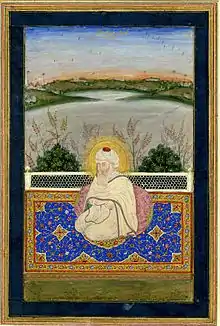Pir (Sufism)
Peer or Pir (Persian: پیر, lit. 'elder')[1] is a title for a Sufi spiritual guide. They are also referred to as a Hazrat (from Arabic: حضرة, romanized: Haḍra) and Sheikh or Shaykh, which is literally the Arabic equivalent. The title is often translated into English as "saint" and could be interpreted as "Elder". In Sufism a Pir's role is to guide and instruct his disciples on the Sufi path.[2] This is often done by general lessons (called Suhbas) and individual guidance. Other words that refer to a Pir include Murshid (Arabic: مرشد, lit. 'guide, mentor') and Sarkar (Persian: سرکار, lit. 'master, lord'). In Alevism, Pir's are considered a direct descendant of Ali.
| Part of a series on Islam Sufism |
|---|
|
|

The title Peer Baba (from Persian: بابا, lit. 'father') is common in the Indian subcontinent used as a salutation to Sufi masters or similarly honored persons. After their death, people visit their tombs or mausolea, referred to as dargah or maqbara.
The path of Sufism starts when a student takes an oath of allegiance with a teacher called Bai'at or Bay'ah (Arabic word meaning "transaction") where he swears allegiance at the hands of his Pir and repents of all his previous sins. After that, the student is called a Murid (Arabic word meaning committed one). From here, his batin (esoteric) journey starts.
A Pir usually has authorizations to be a teacher for one (or more) tariqahs. A tariqah may have more than one Pir at a time. A Pir is accorded that status by his Sheikh by way of Khilafat or Khilafah (Arabic word meaning "succession"), a process in which the Pir identifies one of his disciples as his successor, which may be more than one. The term "Pir" is also used by Nizari Ismailis whose missionaries in the past have used the title Pir. The current Nizari Ismaili Imam Agha Khan IV is also the Pir within the Nizari Ismaili Shia sect.
The Ismaili gināns say that the “Shah occupies the throne of ʿAlī (Alī ke takhat) and the Pīr occupies the prayer carpet of Muḥammad (nabī ke musale)”. Prophet Muhammad is the “Seal of the Prophets (khātam al-nabiyyīn),” (Qurʾan 33:40), indicating that there cannot be any Prophets after him. According to the gināns, Prophet Muhammad is also the first Pir. [3]
See also
- Spiritual direction
- Satya Pir, a folk hero
- Syed Pir Badshah, Persian author of Bengal
- Panchpiria, an ethnic group defined by their reverence for five pirs
- Sufism in Bangladesh, which may also be referred to as "Pirism" because of the central role played by Pirs
References
- Newby, Gordon (2002). A Concise Encyclopedia of Islam (1st ed.). Oxford: One World. p. 173. ISBN 1-85168-295-3.
- "#SelfStyledPeer Kashmir Crown Exposing Fake Baba Molesting Girl In Delina Baramulla. - YouTube". www.youtube.com. Retrieved 2021-02-04.
- Virani, Shafique. "Symphony of Gnosis: A Self-Definition of the Ismaili Ginan Literature". Reason and Inspiration in Islam: Theology, Philosophy and Mysticism in Muslim Thought.
